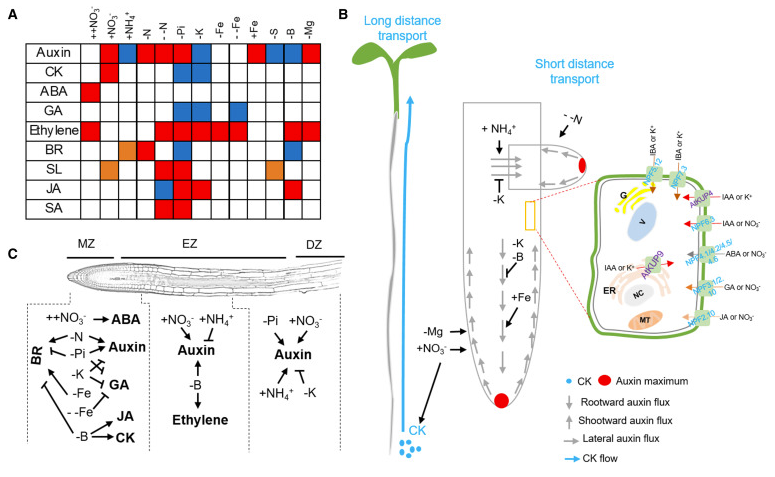 MEET US AT PLANT BIOLOGY 2024 June 22-26, 2024 Honolulu, Hl #309Learn More
MEET US AT PLANT BIOLOGY 2024 June 22-26, 2024 Honolulu, Hl #309Learn More
Plant growth and development requires roots to absorb up to 14 essential mineral elements from the soil. In order to cope with the spatiotemporal variation of these nutrients in soil, plants must dynamically adjust their root structure to optimize the uptake of nutrients. In this process, information about the availability of nutrients in the soil and the needs of the plant is translated into cellular signals. It can be close-up (the root itself) or long-distance (from the stem to the root). These signals usually use phytohormones as intermediates to regulate the cell division or elongation of primary root (PR), the initiation, emergence or elongation of lateral roots (LR), and the formation of root hair (RH).

Nutrient-induced Phytohormone Signaling in Roots
By comparing the changes made by root system architecture (RSA) to the lack of 12 nutrient elements, the researchers found that root-related characteristics (such as the number or length of LR) can individually respond specifically to a certain nutrient element. Hormone homeostasis in plant roots is achieved by maintaining a balance between biosynthesis, metabolic transformation, and degradation. And these processes are highly sensitive to external and internal nutritional signals. In addition to hormonal signals in root cells, nutrients can also induce long-distance transport of hormonal signals, such as nitrogen or magnesium deficiency will promote the upward transport of auxin, while potassium deficiency or high concentration of iron will promote the downward transport of auxin.
PR-associated Phytohormone Signaling
Nitrogen is an important factor to regulate the growth of plant PR, and it mainly regulates the growth of PR through auxin and cytokinin (CK). High concentrations of ammonium nitrogen and nitrate nitrogen can inhibit PR elongation through auxin and CK, respectively; while insufficient nitrogen can activate brassinosteroid (BR) signaling to promote PR elongation. In addition, phosphorus and boron deficiency downregulates BR signaling and inhibits PR elongation, and auxin and CK in PR also respond to potassium deficiency. In addition, gibberellin (GA), ethylene (ET), and jasmonic acid (JA) signals were also involved in PR growth regulated by phosphorus and boron deficiency.
LR-associated Phytohormone Signaling
There are four main processes in the growth of LR: LR initiation, establishment of LR primordia (LRP), emergence and elongation of LR. LR initiation is primarily regulated by nitrogen-induced auxin signaling; phosphorus deficiency also upregulates auxin signaling and promotes LR initiation. The establishment of LRP and the emergence of LR are mainly regulated by nitrogen-induced auxin signaling; potassium deficiency also promotes auxin signaling. In addition, auxin regulates the expression of cell wall enzymes in the upper layer of LR to facilitate the emergence of LR. Different from the previous processes, the elongation of LR is regulated by various plant hormones such as auxin, BR, GA, ET and ABA, and can be induced by high concentration of nitrogen, iron or lack of nitrogen and potassium.
RH-associated Phytohormone Signaling
RH is a kind of root epidermal cells with a short life cycle, and the formation of RH is highly dynamic under the influence of nutrients. Phosphorus deficiency induces auxin biosynthesis, transport, and signaling, as well as ethylene signaling, which regulates the upregulation of RSL2/4 expression, thereby promoting RH elongation. Low phosphorus can also increase RH density by up-regulating the level of strigolactones (SLs), thereby promoting the expression of auxin receptor TIR1. In addition, CK signaling and magnesium deficiency can also increase RH density through ethylene-promoted auxin signaling. Furthermore, potassium and boron deficiency promote root hair elongation through EIN2-dependent ethylene signaling.
Reference:
Jia, Z., Giehl, R.F.H, von Wirén, N. Nutrient-hormone relations: Driving root plasticity in plants. Mol Plant. 2022, 15(1): 86-103.
Liu, Y., von Wirén, N. Integration of nutrient and water availabilities via auxin into the root developmental program. Curr Opin Plant Biol. 2022, 65: 102117.
Oldroyd, G.E.D., Leyser, O. A plant's diet, surviving in a variable nutrient environment. Science. 2020,368: eaba0196.